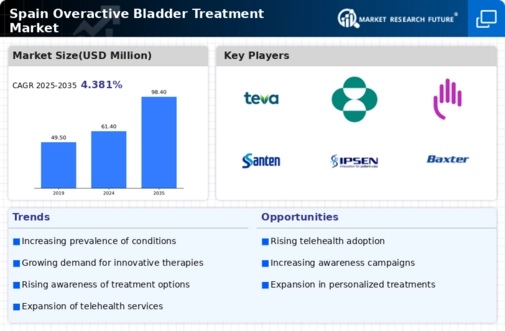Enhanced Healthcare Infrastructure
Spain's healthcare system has seen substantial improvements in recent years, which positively impacts the overactive bladder-treatment market. The government has invested heavily in healthcare infrastructure, leading to better access to medical services and treatments for patients suffering from OAB. With an increase in healthcare facilities and trained professionals, patients are more likely to receive timely diagnoses and appropriate treatment options. Furthermore, the integration of advanced medical technologies into healthcare practices allows for more effective management of OAB symptoms. As a result, the overactive bladder-treatment market is expected to benefit from these enhancements, as patients gain better access to innovative therapies and support services.
Growing Focus on Patient-Centric Care
The shift towards patient-centric care in Spain is influencing the overactive bladder-treatment market significantly. Healthcare providers are increasingly prioritizing patient preferences and experiences, leading to a more tailored approach to treatment. This trend encourages the development of personalized therapies that address the unique needs of individuals suffering from OAB. Additionally, patient education initiatives are being implemented to empower individuals to take an active role in managing their condition. As patients become more informed about their treatment options, they are likely to seek out therapies that align with their lifestyle and preferences. This focus on patient-centric care is expected to drive innovation and competition within the overactive bladder-treatment market.
Aging Population and Demographic Shifts
Spain's demographic landscape is undergoing significant changes, with an increasing proportion of the population aged 65 and older. This demographic shift is particularly relevant to the overactive bladder-treatment market, as older adults are more susceptible to OAB symptoms. It is estimated that nearly 30% of elderly individuals in Spain experience OAB, which necessitates effective treatment options. The growing elderly population is likely to drive demand for specialized therapies and healthcare services tailored to this age group. Consequently, pharmaceutical companies may focus on developing age-appropriate formulations and treatment regimens, thereby enhancing their market presence. The overactive bladder-treatment market is poised for growth as healthcare systems adapt to meet the needs of this aging demographic.
Increasing Prevalence of Overactive Bladder
The rising incidence of overactive bladder (OAB) in Spain is a crucial driver for the overactive bladder-treatment market. Recent studies indicate that approximately 16% of the adult population in Spain experiences symptoms of OAB, which translates to millions of individuals seeking effective treatment options. This growing prevalence is likely to stimulate demand for various therapeutic interventions, including medications and behavioral therapies. As awareness of OAB increases, healthcare providers are more inclined to diagnose and treat this condition, further propelling market growth. The overactive bladder-treatment market is expected to expand as more patients seek relief from the debilitating symptoms associated with OAB, thereby creating a robust environment for pharmaceutical companies and healthcare providers to innovate and offer new solutions.
Rising Investment in Pharmaceutical Research
Investment in pharmaceutical research and development is a key driver for the overactive bladder-treatment market in Spain. With an increasing number of companies focusing on developing new and effective treatments for OAB, the market is witnessing a surge in innovative therapies. Research initiatives are being supported by both public and private sectors, leading to breakthroughs in drug formulations and delivery methods. This influx of investment is likely to enhance the availability of treatment options for patients, thereby expanding the market. As new therapies emerge, the overactive bladder-treatment market is expected to evolve, offering patients more choices and potentially improving their quality of life.






















Leave a Comment